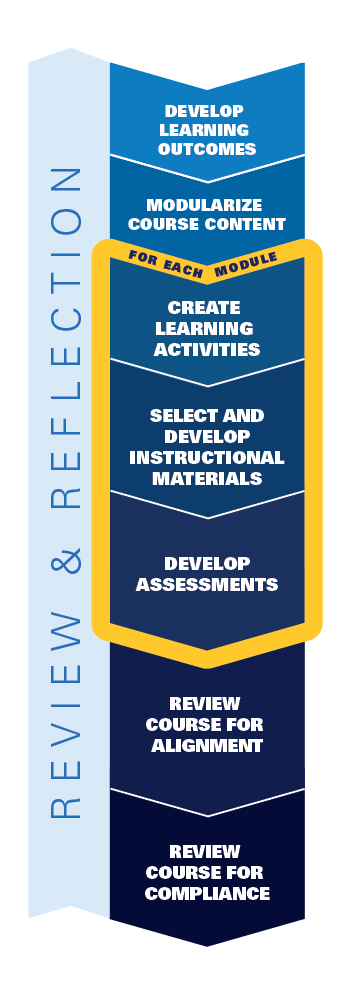- Online Course Development
- Online Program Development
- Program Guidelines
- Accessible Technology
- Center for Teaching and Learning
- Contact Us
- For questions about online teaching or course design, submit your questions to the Learning Technologies portal.
Walk-in Consultation Hours
Monday-Friday 9 a.m. - 3 p.m.
Room 326 Raynor Library
PROBLEM WITH THIS WEBPAGE?Report an accessibility problem
To report another problem, please contact emily.newell@marquette.edu.
Instructional Design Model
The development of an online course begins with a kickoff meeting where the faculty member is paired with an Instructional Designer. During this meeting, the Design Team listens carefully to the faculty member to determine what she/he thinks about the teaching and learning process. The team also assesses faculty’s experience with teaching online, and listens to ideas about content, activities, and preferred strategies for assessment.

- Develop Learning Outcomes
Faculty identifies what students are expected to be able to do/know by the end of the course. What skill set are they expected to leave with? What knowledge is desired for retention and transfer? - Modularize Course Content
Faculty, in collaboration with the instructional designer, identifies the natural divisions in the course and brainstorms how the content “hangs together”: By topic? By chronology? By process?
- Create Learning Activities
The instructional designer and faculty create opportunities for students to practice the skills and knowledge articulated by the learning outcomes. What can learners “produce” to make connections and apply concepts?
- Select and Develop Instructional Materials
Faculty works with the Design Team to identify and develop materials and resources to complete the learning activities. E.g. articles, websites, simulations, video demonstrations or tours, immersive learning experiences (Virtual Reality), etc.
- Develop Assessments
The faculty and instructional designer collaborate to design online components that will indicate the degree to which students have mastered the learning outcomes. How will students demonstrate mastery of the skills and knowledge articulated by the learning outcomes?
- Review Course for Alignment
Each module is reviewed to check alignment between the learning outcomes, resources, learning activities, and assessments of student learning. In some cases the learning outcomes may be met by overarching, course-long or cumulative projects or assessments. Similarly, the sections of learning (or modules) should align with the course learning outcomes.
- Review Course for Compliance
Faculty and the Design Team review the final course for ADA compliance, copyright, and FERPA, and ensure that all media, navigation, and tools work.
*Although the revision of the course is listed at the end, revision and reflection are ongoing during the course development process.
